
The study of classical electromagnetic fields is an adventure. The theory is complete mathematically and we are able to present it as an example of classical Newtonian experimental and mathematical philosophy. There is a set of foundational experiments, on which most of the theory is constructed. And then there is the bold theoretical proposal of a field-field interaction from James Clerk Maxwell. . This textbook presents the theory of classical fields as a mathematical structure based solidly on laboratory experiments. Here the student isintroduced to the beauty of classical field theory as a gem of theoretical physics. To keep the discussion fluid, the history is placed in a beginning chapter and some of the mathematical proofs in the appendices. Chapters on Green’sFunctions and Laplace’s Equation and a discussion of Faraday’s Experiment further deepen the understanding. The chapter on Einstein’s relativity is an integral necessity to the text. Finally, chapters on particle motion and waves in a dispersive medium complete the picture. High quality diagrams and detailed end-of-chapter questions enhance the learning experience. Gives a thorough and logical exposition of the theory of electromagnetism,enriched with historical details. High quality diagrams and end of chapter questions support fast learning progress. Course tested and approved for many years. Rich text book features include end-of-chapter questions, problems and solutions, separate complete solutions manual available. INDICE: Origins and Concepts. Mathematical Background. Electrostatics. TheScalar Potential. Magnetostatics. Applications of Magnetostatics. Particle Motion. Green?s Functions. Laplace? Equation. Time Dependence. Electromagnetic Waves. Energy and Momentum. Special Relativity. Radiation. Fields in Matter. Waves in Dispersive Media. Appendix.
- ISBN: 978-3-642-23204-6
- Editorial: Springer Berlin Heidelberg
- Encuadernacion: Cartoné
- Páginas: 454
- Fecha Publicación: 30/11/2011
- Nº Volúmenes: 1
- Idioma: Inglés
